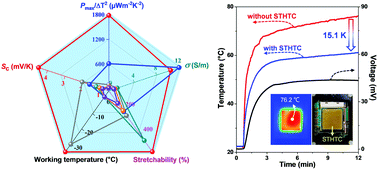Stretchable thermogalvanic hydrogel thermocell with record-high specific output power density enabled by ion-induced crystallization†
Abstract
Ionic thermocells have relatively high thermopowers based on the thermogalvanic effect, but their small electricity output is still insufficient for practical applications. We demonstrated a highly ionic conductive, anti-freezing stretchable thermogalvanic hydrogel thermocell (STHTC) with a record-high specific output power density of 1780 μW m−2 K−2, which is ∼3 times the maximum value of previously reported STHTCs. The guanidine ion induces [Fe(CN)6]4− ion crystallization and significantly enhances the thermogalvanic effect. The giant thermopower and stretchability are as high as 4.4 mV K−1 and 540%, respectively. Even at a low operating temperature of −35 °C, the STHTC still exhibits good thermoelectrical performance. As a wearable device, a STHTC array device has been demonstrated to directly light up five green LEDs by simulating harvesting low-grade human thermal energy. By placing the STHTC on the surface of a normal working Central Processing Unit, it proves a feasible strategy for simultaneous thermal management and power generation.



 Please wait while we load your content...
Please wait while we load your content...